#computer modeling
Text
pre-fallen tiny little itty bitty body Lucifer? YES PLEASE
this was SO FUN to make
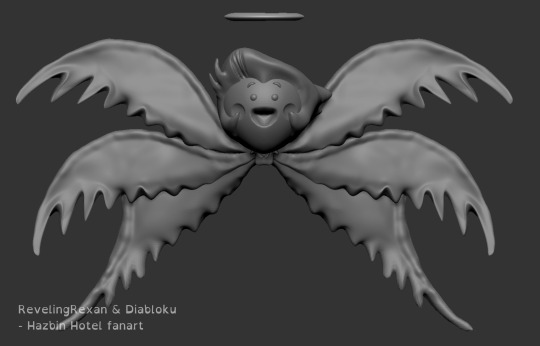

modeled by me for an assignment, design originally by @diabloku in their "ALASTOR'S VICIOUS MOCKERY" video


youtube
(some more angles and a bonus cursed alternate version under the cut)
_______
some more angles to answer a question some people might have, like "HOW DID YOU EVEN GET THOSE WINGS TO FIT ON HIS BODY" (a few people asked me that lol. or at least one person did. i think a second person--ANYWAY)
answer: curve the wings out A LOT away from the body and give them tiny bases
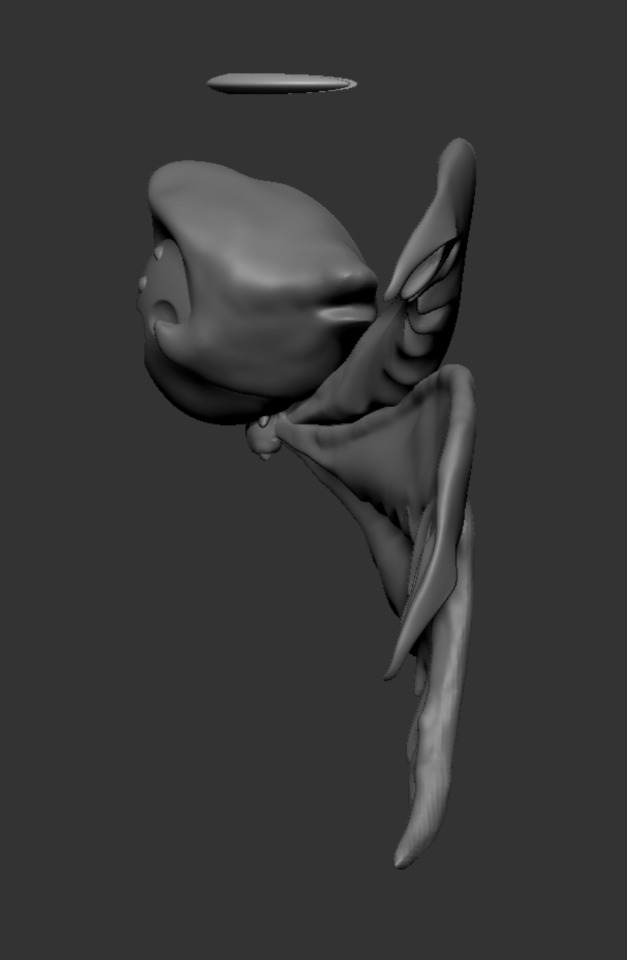

BONUS: I HAD TOO MUCH FUN AND FORGOT THE ASSIGNMENT WAS ACTUALLY TO CREATE A BUST (HEAD AND SHOULDERS), NOT A WHOLE BODY, AND I DIDN'T KNOW HOW PEDANTIC MY PROFESSOR WOULD BE, SO I MADE THIS VERSION TOO

i wish i remembered to include his collarbone and some neck muscles. it would have been even more cursed
(more bonus info: i'm new-ish to the program we're using [ZBrush], so i didn't realize there's a torus -- a ring -- object i could have used for the halo. so i squashed a sphere and tried to cut a circle out from the center, but the program didn't cooperate. so i instead gave him a semi-halo thing lol)
#hazbin hotel#hazbin lucifer#lucifer morningstar#hazbin hotel lucifer#rexan's art#zbrush#3d modeling#3d art#computer modeling#it was so silly that i collected a bunch of bird wing references and then hardly used them or my knowledge from past projects lol#Youtube
71 notes
·
View notes
Text
Centriole Building
The centriole – an organelle vital for the faithful separation into each daughter cell when a cell divides – is composed of an assembly of proteins. Using expansion microscopy, this study correlates the spatial location of 24 of those proteins with structural features of the human centriole, and then models the molecular architecture of the centriole as it assembles (shown here)
Read the published research article here
Video from work by Marine H. Laporte and colleagues
University of Geneva, Department of Molecular and Cellular Biology, Faculty of Sciences, Geneva, Switzerland
Video originally published with a Creative Commons Attribution 4.0 International (CC BY-NC 4.0)
Published in Cell, April 2024
You can also follow BPoD on Instagram, Twitter and Facebook
#science#biomedicine#biology#cell division#centrioles#centrosome#computer modeling#expansion microscopy
12 notes
·
View notes
Text
Two MIT PhD students awarded J-WAFS fellowships for their research on water
New Post has been published on https://thedigitalinsider.com/two-mit-phd-students-awarded-j-wafs-fellowships-for-their-research-on-water/
Two MIT PhD students awarded J-WAFS fellowships for their research on water


Since 2014, the Abdul Latif Jameel Water and Food Systems Lab (J-WAFS) has advanced interdisciplinary research aimed at solving the world’s most pressing water and food security challenges to meet human needs. In 2017, J-WAFS established the Rasikbhai L. Meswani Water Solutions Fellowship and the J-WAFS Graduate Student Fellowship. These fellowships provide support to outstanding MIT graduate students who are pursuing research that has the potential to improve water and food systems around the world.
Recently, J-WAFS awarded the 2024-25 fellowships to Jonathan Bessette and Akash Ball, two MIT PhD students dedicated to addressing water scarcity by enhancing desalination and purification processes. This work is of important relevance since the world’s freshwater supply has been steadily depleting due to the effects of climate change. In fact, one-third of the global population lacks access to safe drinking water. Bessette and Ball are focused on designing innovative solutions to enhance the resilience and sustainability of global water systems. To support their endeavors, J-WAFS will provide each recipient with funding for one academic semester for continued research and related activities.
“This year, we received many strong fellowship applications,” says J-WAFS executive director Renee J. Robins. “Bessette and Ball both stood out, even in a very competitive pool of candidates. The award of the J-WAFS fellowships to these two students underscores our confidence in their potential to bring transformative solutions to global water challenges.”
2024-25 Rasikbhai L. Meswani Fellowship for Water Solutions
The Rasikbhai L. Meswani Fellowship for Water Solutions is a doctoral fellowship for students pursuing research related to water and water supply at MIT. The fellowship is made possible by Elina and Nikhil Meswani and family.
Jonathan Bessette is a doctoral student in the Global Engineering and Research (GEAR) Center within the Department of Mechanical Engineering at MIT, advised by Professor Amos Winter. His research is focused on water treatment systems for the developing world, mainly desalination, or the process in which salts are removed from water. Currently, Bessette is working on designing and constructing a low-cost, deployable, community-scale desalination system for humanitarian crises.
In arid and semi-arid regions, groundwater often serves as the sole water source, despite its common salinity issues. Many remote and developing areas lack reliable centralized power and water systems, making brackish groundwater desalination a vital, sustainable solution for global water scarcity.
“An overlooked need for desalination is inland groundwater aquifers, rather than in coastal areas,” says Bessette. “This is because much of the population lives far enough from a coast that seawater desalination could never reach them. My work involves designing low-cost, sustainable, renewable-powered desalination technologies for highly constrained situations, such as drinking water for remote communities,” he adds.
To achieve this goal, Bessette developed a batteryless, renewable electrodialysis desalination system. The technology is energy-efficient, conserves water, and is particularly suited for challenging environments, as it is decentralized and sustainable. The system offers significant advantages over the conventional reverse osmosis method, especially in terms of reduced energy consumption for treating brackish water. Highlighting Bessette’s capacity for engineering insight, his advisor noted the “simple and elegant solution” that Bessette and a staff engineer, Shane Pratt, devised that negated the need for the system to have large batteries. Bessette is now focusing on simplifying the system’s architecture to make it more reliable and cost-effective for deployment in remote areas.
Growing up in upstate New York, Bessette completed a bachelor’s degree at the State University of New York at Buffalo. As an undergrad, he taught middle and high school students in low-income areas of Buffalo about engineering and sustainability. However, he cited his junior-year travel to India and his experience there measuring water contaminants in rural sites as cementing his dedication to a career addressing food, water, and sanitation challenges. In addition to his doctoral research, his commitment to these goals is further evidenced by another project he is pursuing, funded by a J-WAFS India grant, that uses low-cost, remote sensors to better understand water fetching practices. Bessette is conducting this work with fellow MIT student Gokul Sampath in order to help families in rural India gain access to safe drinking water.
2024-25 J-WAFS Graduate Student Fellowship for Water and Food Solutions
The J-WAFS Graduate Student Fellowship is supported by the J-WAFS Research Affiliate Program, which offers companies the opportunity to engage with MIT on water and food research. Current fellowship support was provided by two J-WAFS Research Affiliates: Xylem, a leading U.S.-based provider of water treatment and infrastructure solutions, and GoAigua, a Spanish company at the forefront of digital transformation in the water industry through innovative solutions.
Akash Ball is a doctoral candidate in the Department of Chemical Engineering, advised by Professor Heather Kulik. His research focuses on the computational discovery of novel functional materials for energy-efficient ion separation membranes with high selectivity. Advanced membranes like these are increasingly needed for applications such as water desalination, battery recycling, and removal of heavy metals from industrial wastewater.
“Climate change, water pollution, and scarce freshwater reserves cause severe water distress for about 4 billion people annually, with 2 billion in India and China’s semiarid regions,” Ball notes. “One potential solution to this global water predicament is the desalination of seawater, since seawater accounts for 97 percent of all water on Earth.”
Although several commercial reverse osmosis membranes are currently available, these membranes suffer several problems, like slow water permeation, permeability-selectivity trade-off, and high fabrication costs. Metal-organic frameworks (MOFs) are porous crystalline materials that are promising candidates for highly selective ion separation with fast water transport due to high surface area, the presence of different pore windows, and the tunability of chemical functionality.
In the Kulik lab, Ball is developing a systematic understanding of how MOF chemistry and pore geometry affect water transport and ion rejection rates. By the end of his PhD, Ball plans to identify existing, best-performing MOFs with unparalleled water uptake using machine learning models, propose novel hypothetical MOFs tailored to specific ion separations from water, and discover experimental design rules that enable the synthesis of next-generation membranes.
Ball’s advisor praised the creativity he brings to his research, and his leadership skills that benefit her whole lab. Before coming to MIT, Ball obtained a master’s degree in chemical engineering from the Indian Institute of Technology (IIT) Bombay and a bachelor’s degree in chemical engineering from Jadavpur University in India. During a research internship at IIT Bombay in 2018, he worked on developing a technology for in situ arsenic detection in water. Like Bessette, he noted the impact of this prior research experience on his interest in global water challenges, along with his personal experience growing up in an area in India where access to safe drinking water was not guaranteed.
#2024#Accounts#applications#architecture#Awards#honors and fellowships#batteries#battery#billion#career#change#chemical#Chemical engineering#chemistry#China#climate#climate change#Community#Companies#Computer modeling#creativity#crystalline#crystalline materials#deployment#Desalination#Design#detection#Digital Transformation#drinking#drinking water
0 notes
Text
Comprehensive Seismic Engineering Design Services Offered by Little P.Eng. and its Importance in Piping Stress Analysis
In the world of engineering and construction, seismic engineering is a specialized field crucial for ensuring the safety and resilience of structures in earthquake-prone regions. Little P.Eng. is a renowned seismic engineering firm that provides a wide range of services to address the unique challenges posed by seismic activity. In this comprehensive article, we will explore the multitude of services offered by Little P.Eng., highlighting their expertise, innovation, and dedication to creating structures that can withstand the forces of nature.
Seismic Risk Assessment
One of the foundational services offered by Little P.Eng. is seismic risk assessment. Before embarking on any seismic engineering project, it's essential to understand the level of risk posed by potential earthquakes in a specific area. Little P.Eng. utilizes advanced methodologies and data analysis to assess seismic hazards accurately. This assessment helps clients make informed decisions about construction and retrofitting, ensuring the safety of occupants and the protection of valuable assets.
Structural Analysis and Design
Seismic engineering begins with the structural analysis and design of buildings and infrastructure. Little P.Eng.'s team of experienced engineers specializes in developing seismic-resistant structural systems. They work closely with architects, builders, and developers to create designs that can withstand seismic forces, ensuring structural integrity and occupant safety during earthquakes.
Retrofitting Existing Structures
In regions with older buildings, retrofitting is often necessary to bring them up to current seismic safety standards. Little P.Eng. offers retrofitting services that involve the modification and strengthening of existing structures. Their engineers assess the specific needs of each building, considering factors such as its age, construction materials, and seismic vulnerabilities. They then implement retrofitting strategies that enhance the building's earthquake resistance, preserving its historical value while ensuring safety.
Foundation Design and Soil Analysis
The foundation is the bedrock of any structure's stability during an earthquake. Little P.Eng. conducts in-depth soil analysis to understand the geotechnical characteristics of the site. Based on this analysis, they design and recommend appropriate foundation systems tailored to the specific needs of the project. Their expertise in foundation design ensures that structures can effectively dissipate seismic forces into the ground, preventing catastrophic failure.
Compliance with Seismic Codes
Adherence to seismic codes and standards is paramount in seismic engineering. Little P.Eng. has an in-depth understanding of local, national, and international building codes related to earthquake-resistant construction. They ensure that all their designs and retrofitting projects comply with these regulations, providing clients with peace of mind that their structures meet the highest safety standards.
Advanced Computer Modeling and Simulation
Little P.Eng. leverages cutting-edge computer modeling and simulation tools to analyze and predict how structures will respond to seismic forces. These simulations allow for precise refinement of designs and provide valuable insights into structural performance during earthquakes. By simulating a wide range of seismic scenarios, engineers can optimize designs for maximum safety and efficiency.
Continuous Monitoring and Evaluation
The commitment of Little P.Eng. extends beyond the design and construction phase. They recommend and implement structural health monitoring systems that allow for real-time assessment of a building's integrity. Continuous monitoring enables early detection of potential issues, ensuring prompt maintenance or repairs to preserve structural stability.
Research and Innovation
Innovation is at the heart of Little P.Eng.'s approach to seismic engineering. Their team actively engages in research and development to push the boundaries of seismic-resistant technologies and construction practices. They explore innovative materials, construction techniques, and design methodologies to advance the field and provide clients with the latest and most effective solutions.
Emergency Response Planning
In addition to structural engineering services, Little P.Eng. assists communities, businesses, and organizations in developing emergency response plans for seismic events. They collaborate with stakeholders to create comprehensive strategies for minimizing risks, protecting lives, and reducing damage during earthquakes.
Public Education and Outreach
Little P.Eng. recognizes the importance of public awareness and education regarding seismic risks and safety. They engage in outreach programs to educate communities on earthquake preparedness, emergency response, and the importance of seismic-resistant construction.
Conclusion

Seismic engineering design plays a crucial role in piping stress analysis within industrial facilities, especially in regions prone to earthquakes. Piping stress analysis involves evaluating the forces and stresses that piping systems experience during various operational conditions, including seismic events.
Here's how seismic engineering design is important for piping stress analysis:
Safety and Structural Integrity: Seismic engineering design ensures that the entire facility, including piping systems, is built to withstand the forces generated by earthquakes. The structural integrity of piping systems is paramount for preventing leaks, ruptures, or catastrophic failures during seismic events. Piping stress analysis assesses the impact of seismic forces on the pipes, supports, and attachments to verify that they can withstand the dynamic loads and deformations caused by earthquakes.
Compliance with Building Codes: Piping systems within industrial facilities must adhere to building codes and standards related to earthquake-resistant design. Seismic engineering design ensures that piping systems are compliant with these codes. Non-compliance can lead to costly retrofitting efforts or, in the worst-case scenario, dangerous failures during an earthquake.
Identifying Vulnerabilities: Seismic engineering design involves conducting a seismic risk assessment for the facility. This assessment helps identify vulnerabilities in the piping systems, such as weak points in support structures or connections that may be prone to failure during seismic events. Piping stress analysis considers these vulnerabilities and recommends improvements to enhance seismic resilience.
Optimal Pipe Routing and Support: Piping stress analysis incorporates considerations for seismic forces when determining the routing of pipes and the design of pipe supports. Proper pipe routing and support are essential to prevent excessive stresses, vibrations, and displacements during an earthquake. Seismic engineering design helps optimize these factors to minimize potential damage to the piping systems.
Dynamic Load Analysis: Seismic events introduce dynamic loads on piping systems, which are significantly different from static loads. Piping stress analysis uses dynamic load analysis techniques to simulate the effects of seismic forces on pipes, fittings, and supports. This analysis ensures that the piping systems can handle the dynamic loads without exceeding their stress limits.
Retrofitting and Modifications: In existing facilities, seismic engineering design may involve retrofitting or modifying piping systems to meet current seismic standards. Piping stress analysis helps identify areas that require reinforcement, redesign, or additional support. Retrofitting ensures that older facilities can withstand seismic events and meet modern safety requirements.
Mitigation Strategies: Seismic engineering design doesn't only focus on evaluating existing conditions but also includes the development of mitigation strategies. These strategies may involve the use of seismic expansion joints, dampers, or flexible connectors to absorb seismic energy and reduce stress on the piping systems.
Emergency Response Planning: In the event of a seismic event, having a well-designed piping system is crucial for quick recovery and minimizing damage. Seismic engineering design contributes to emergency response planning by ensuring that piping systems are less likely to rupture or leak during an earthquake, reducing potential hazards and environmental damage.
In summary, seismic engineering design is vital for piping stress analysis because it ensures the safety, compliance, and resilience of piping systems in the face of seismic events. It helps identify vulnerabilities, optimize designs, and implement mitigation measures, ultimately safeguarding industrial facilities and the surrounding environment during earthquakes.
The listing below indicates a few of Meena Development’s most commonly served industries.
Steel and Metals Industry
Energy and Power Generation Industry
Water and Wastewater Industry
Oil & Gas Industry
Chemicals and Plastics Industry
Pulp & Paper Industry
Facility Services
Residential Buildings Sector
Hospitality and Hotel Sector
Commercial Buildings Sectors
Sports and Stadia Buildings Sector
Education Buildings Sector
Government Buildings Sector
Hospitals Engineering Services
Biotech / Pharmaceutical – Engineering Services
Food & Beverage – Engineering Services
Tags:
Meena Rezkallah
Little P.Eng.
piping stress analysis
Piping stress analysis
Structural analysis
Seismic engineering
Seismic risk assessment
Retrofitting
Foundation design
Compliance with seismic codes
Computer modeling
Advanced simulation
Optimal pipe routing
Support systems
Pipe design
Seismic forces
Seismic expansion joints
Flexible connectors
Engineering Services
Pipe Stress Analysis Services
Seismic Bracing Experts
Located in Calgary, Alberta; Vancouver, BC; Toronto, Ontario; Edmonton, Alberta; Houston Texas; Torrance, California; El Segundo, CA; Manhattan Beach, CA; Concord, CA; We offer our engineering consultancy services across Canada and United States. Meena Rezkallah.
#•#Meena Rezkallah#Little P.Eng.#piping stress analysis#Piping stress analysis#Structural analysis#Seismic engineering#Seismic risk assessment#Retrofitting#Foundation design#Compliance with seismic codes#Computer modeling#Advanced simulation#Optimal pipe routing#Support systems#Pipe design#Seismic forces#Seismic expansion joints#Flexible connectors
0 notes
Text
Even for complex polymeric reactions, researchers at the Australian National University have developed chemically accurate techniques for predicting rate constants and have used them to successfully predict the outcomes of multi-component polymerisation processes (see figure 15.27).

"Chemistry" 2e - Blackman, A., Bottle, S., Schmid, S., Mocerino, M., Wille, U.
#book quotes#chemistry#nonfiction#textbook#computer modeling#australian national university#prediction#iraft#imraft#immraft#polymerization#chemical reactions
1 note
·
View note
Text

"Mhmm... Yyyyeah... Gonna need to retopo that..."
#blender art#learning blender#blender model#blender#blender 3d#3d modeling#modeling#computer modeling#retopology#retopo#shitpost#meme
0 notes
Text
don't panic buy games because of the eshop shutdown!!!! the memes are not lying It is genuinely very easy to hack your 3ds!!! please do it!!!!
3ds.hacks.guide
(don't follow video guides they are very often outdated and it's easier to make mistakes that way. this guide is very detailed with step by step instructions and they even have a support server in the event you have any trouble! i understand it might seem intimidating but risks of bricking or banning are very minimal at this point you will be glad you did it)
#bri talks#the only tools you'll need is a computer and a way to read mini sd cards#if you have the New Nintendo 3DS XL model you're also gonna need a certain screwdriver to open the back plate#because for some reason ninty put it there#any other model has easy sd card access so if you have a regular 3ds/xl/any 2ds model you don't need that#i have NO idea why they put it there it's not like they're even against you using a different sd card#there's instructions to change it on nintendo support... like...
40K notes
·
View notes
Photo
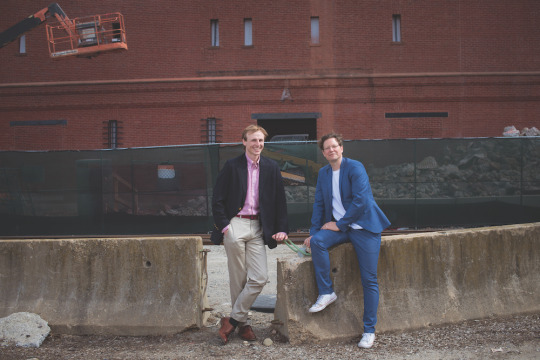
Cutting urban carbon emissions by retrofitting buildings
Study shows that cities’ plans often won’t achieve their goals, but decarbonizing the local grid could make the difference.
https://news.mit.edu/2023/cutting-urban-carbon-emissions-retrofitting-buildings-0713
#School of Architecture and Planning#Architecture#MIT Energy Initiative#Energy#Energy efficiency#Climate change#Emissions#Greenhouse gases#Sustainability#Policy#Computer modeling#Research#Cities#Nancy W. Stauffer | MIT Energy Initiative#MIT News
0 notes
Text
Trimester 2- Computer Modeling
Using references gathered through the use of a pinterest board, the theatre began to shape up as I spent the time making smaller details such as the knobs on the front sign and the details of the brick work inorder to add more to the cluttered nature of okder architecture.
Additionally I decided to implement a small narrative within the work, providing a stronger sense of personality to the piece as a whole. Behind the theatre a back door is open and a stool has been placed by a bin, in my mind I like to think that the employees of the theatre might sometimes sneak out during their breaks and sit outside to be alone for a while. This relaxed attitude to their work has attributed to a pile up of old popcorn cans on the front table outside of the theatre.
Finally I built up a mostly warm colour palette using reds, oranges and yellows, I feel this contributes a cohesiveness to the building as a whole making it pleasant to look at despite the mixture of real life textures and flat colours being used inorder to decorate it.
As a whole I found maya quite difficult to use due to the many windows however I find that spending a lot of time redoing certain actions leads to a stronger sense of understanding and I can now apply texture with ease.

0 notes
Text
Techbro marketing's conflation of generative language models with the term "artifical intelligence" to the point that many laypersons now think that's what AI is definitely sucks for, like, literally everybody who's working in genuine AI research, but I have to grant the way it's gotten tangled up with other historically inappropriate uses of the term "artificial intelligence" is a little bit funny. I've seen multiple unconnected discussions involving people seizing on the "AI is inherently unethical" talking point and getting heated about bad guys in single-player video games having "AI", and, like, I'd be fascinated to know what the alternative is. I'm trying to imagine a world where it's feasible for every individual goomba in Super Mario Bros. to be directed by a human operator, and I'm not sure I can, but it's definitely a place I'd like to visit.
#computers#technology#artificial intelligence#ai#generative language models#gaming#video games#marketing#nomenclature
2K notes
·
View notes
Text



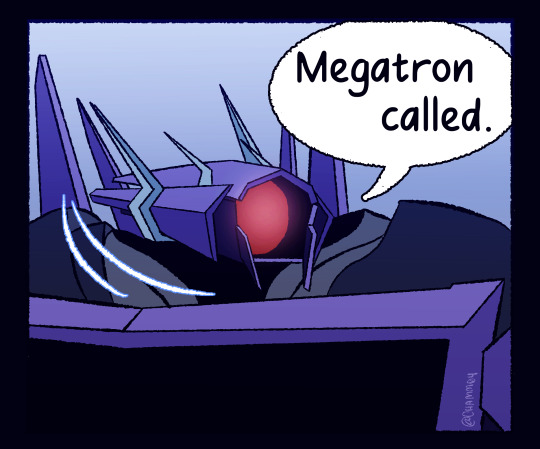


RUMBLE FRENZY WHOEVER WHAT DID YOU DO???
that one tiktok audio bc i thought it was really funny (go watch the tiktok i love stopmotion lmao)
@vivificanousprime
#tf#shockwave#soundwave#wavewave#tf rumble#tf frenzy#maccadam#transfromers#logical proposals#id do a tiktok too but... idk how#plz imagine theres a computer behind shockwave lmaoaoao i got lazy at the end#backgrounds are my enemy#backgrounds and shockwaves canon cable#curse you prime models#chammoyart
515 notes
·
View notes
Text

#fnaf#crunchchute art#my art#five nights at freddy's#five nights at freddys#this thing froze my pc 4 times now im posting it as is im not drawing any more#glitchtrap#help wanted 2#fnaf help wanted 2#fnaf help wanted#you can tell which song i remembered while drawing this#also now im listening to cabinet man and am like yippee they should make a song that is like computer boy and cabinet man mixed together#nobody reads tags to this far. have you seen this guys tail? go load up his model on sketchfab or something. and then come back.#its dipped in. no.. i shant say... *makes a pained expression*#fnaf help wanted 2 spoilers#help wanted 2 spoilers#number 15: the rabbit computer virus. the last thing youd want in your computer is someones rabbit fungus
899 notes
·
View notes
Text
Behind the Wave
Computer model of a 'carpet' of beating cilia – the whisker-like structures on many body cell types that sense or waft – reveals the mechanism of their synchronisation. Watch the emergence of a metachronal wave (a Mexican wave is one of these)
Read the published research paper here
Video adapted from work by David J. Hickey, Ramin Golestanian and Andrej Vilfan
Department of Living Matter Physics, Max Planck Institute for Dynamics and Self-Organization, Göttingen, Germany
Video originally published with a Creative Commons Attribution 4.0 International (CC BY 4.0)
Published in Proceedings of the National Academy of Science (PNAS), September 2023
You can also follow BPoD on Instagram, Twitter and Facebook
17 notes
·
View notes
Text
Fostering research, careers, and community in materials science
New Post has been published on https://thedigitalinsider.com/fostering-research-careers-and-community-in-materials-science/
Fostering research, careers, and community in materials science
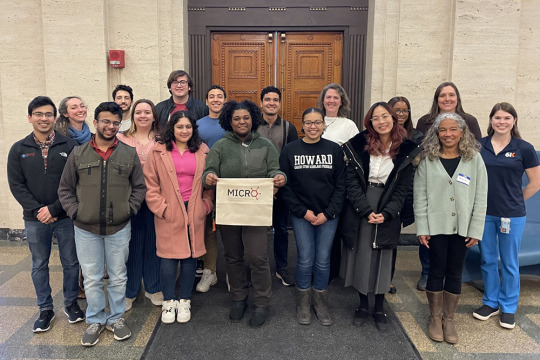

Gabrielle Wood, a junior at Howard University majoring in chemical engineering, is on a mission to improve the sustainability and life cycles of natural resources and materials. Her work in the Materials Initiative for Comprehensive Research Opportunity (MICRO) program has given her hands-on experience with many different aspects of research, including MATLAB programming, experimental design, data analysis, figure-making, and scientific writing.
Wood is also one of 10 undergraduates from 10 universities around the United States to participate in the first MICRO Summit earlier this year. The internship program, developed by the MIT Department of Materials Science and Engineering (DMSE), first launched in fall 2021. Now in its third year, the program continues to grow, providing even more opportunities for non-MIT undergraduate students — including the MICRO Summit and the program’s expansion to include Northwestern University.
“I think one of the most valuable aspects of the MICRO program is the ability to do research long term with an experienced professor in materials science and engineering,” says Wood. “My school has limited opportunities for undergraduate research in sustainable polymers, so the MICRO program allowed me to gain valuable experience in this field, which I would not otherwise have.”
Like Wood, Griheydi Garcia, a senior chemistry major at Manhattan College, values the exposure to materials science, especially since she is not able to learn as much about it at her home institution.
“I learned a lot about crystallography and defects in materials through the MICRO curriculum, especially through videos,” says Garcia. “The research itself is very valuable, as well, because we get to apply what we’ve learned through the videos in the research we do remotely.”
Expanding research opportunities
From the beginning, the MICRO program was designed as a fully remote, rigorous education and mentoring program targeted toward students from underserved backgrounds interested in pursuing graduate school in materials science or related fields. Interns are matched with faculty to work on their specific research interests.
Jessica Sandland ’99, PhD ’05, principal lecturer in DMSE and co-founder of MICRO, says that research projects for the interns are designed to be work that they can do remotely, such as developing a machine-learning algorithm or a data analysis approach.
“It’s important to note that it’s not just about what the program and faculty are bringing to the student interns,” says Sandland, a member of the MIT Digital Learning Lab, a joint program between MIT Open Learning and the Institute’s academic departments. “The students are doing real research and work, and creating things of real value. It’s very much an exchange.”
Cécile Chazot PhD ’22, now an assistant professor of materials science and engineering at Northwestern University, had helped to establish MICRO at MIT from the very beginning. Once at Northwestern, she quickly realized that expanding MICRO to Northwestern would offer even more research opportunities to interns than by relying on MIT alone — leveraging the university’s strong materials science and engineering department, as well as offering resources for biomaterials research through Northwestern’s medical school. The program received funding from 3M and officially launched at Northwestern in fall 2023. Approximately half of the MICRO interns are now in the program with MIT and half are with Northwestern. Wood and Garcia both participate in the program via Northwestern.
“By expanding to another school, we’ve been able to have interns work with a much broader range of research projects,” says Chazot. “It has become easier for us to place students with faculty and research that match their interests.”
Building community
The MICRO program received a Higher Education Innovation grant from the Abdul Latif Jameel World Education Lab, part of MIT Open Learning, to develop an in-person summit. In January 2024, interns visited MIT for three days of presentations, workshops, and campus tours — including a tour of the MIT.nano building — as well as various community-building activities.
“A big part of MICRO is the community,” says Chazot. “A highlight of the summit was just seeing the students come together.”
The summit also included panel discussions that allowed interns to gain insights and advice from graduate students and professionals. The graduate panel discussion included MIT graduate students Sam Figueroa (mechanical engineering), Isabella Caruso (DMSE), and Eliana Feygin (DMSE). The career panel was led by Chazot and included Jatin Patil PhD ’23, head of product at SiTration; Maureen Reitman ’90, ScD ’93, group vice president and principal engineer at Exponent; Lucas Caretta PhD ’19, assistant professor of engineering at Brown University; Raquel D’Oyen ’90, who holds a PhD from Northwestern University and is a senior engineer at Raytheon; and Ashley Kaiser MS ’19, PhD ’21, senior process engineer at 6K.
Students also had an opportunity to share their work with each other through research presentations. Their presentations covered a wide range of topics, including: developing a computer program to calculate solubility parameters for polymers used in textile manufacturing; performing a life-cycle analysis of a photonic chip and evaluating its environmental impact in comparison to a standard silicon microchip; and applying machine learning algorithms to scanning transmission electron microscopy images of CrSBr, a two-dimensional magnetic material.
“The summit was wonderful and the best academic experience I have had as a first-year college student,” says MICRO intern Gabriella La Cour, who is pursuing a major in chemistry and dual degree biomedical engineering at Spelman College and participates in MICRO through MIT. “I got to meet so many students who were all in grades above me … and I learned a little about how to navigate college as an upperclassman.”
“I actually have an extremely close friendship with one of the students, and we keep in touch regularly,” adds La Cour. “Professor Chazot gave valuable advice about applications and recommendation letters that will be useful when I apply to REUs [Research Experiences for Undergraduates] and graduate schools.”
Looking to the future, MICRO organizers hope to continue to grow the program’s reach.
“We would love to see other schools taking on this model,” says Sandland. “There are a lot of opportunities out there. The more departments, research groups, and mentors that get involved with this program, the more impact it can have.”
#2023#2024#Abdul Latif Jameel World Education Lab (J-WEL)#Advice#algorithm#Algorithms#Alumni/ae#Analysis#applications#approach#Building#career#Careers#chemical#Chemical engineering#chemistry#Classes and programs#Collaboration#college#Community#comparison#comprehensive#computer#Computer modeling#Computer science and technology#data#data analysis#Design#Digital technology#DMSE
0 notes
Text
"what’s your fursona" this and "what does your blog smell like" that... tell me in the tags what your object head sona would be
#obviously mine would be. a computer or tv minotor#most likely a beige gateway model like the one i grew up with#or a white imac g3#or the transparent panasonic tv i've posted here before
6K notes
·
View notes
Text
For example, additives such as the ethylenediaminetetraphosphonate anion can substitute for sulfate anions at the surface of a barium sulfate crystal; the system can be modelled in the computer (figure 10.19) to determine the most favourable binding sites.

"Chemistry" 2e - Blackman, A., Bottle, S., Schmid, S., Mocerino, M., Wille, U.
#book quotes#chemistry#nonfiction#textbook#additives#ethylenediaminetetraphosphonate#anion#ions#sulfate#substitution#barium sulfate#computer modeling
0 notes